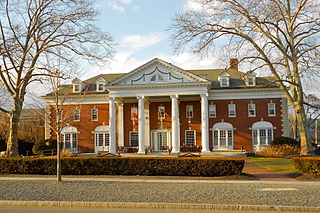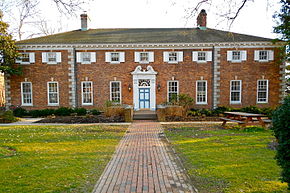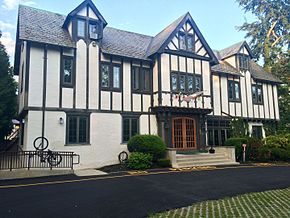
Princeton University is a private Ivy League research university in Princeton, New Jersey. Founded in 1746 in Elizabeth as the College of New Jersey, Princeton is the fourth-oldest institution of higher education in the United States and one of the nine colonial colleges chartered before the American Revolution. The institution moved to Newark in 1747, and then to its current campus, nine years later. It officially became a university in 1896 and was subsequently renamed Princeton University.

The American Whig–Cliosophic Society, sometimes abbreviated as Whig-Clio, is a political, literary, and debating society at Princeton University and the oldest debate union in the United States. Its precursors, the American Whig Society and the Cliosophic Society, were founded at Princeton in 1769 and 1765 by James Madison, William Paterson, Oliver Ellsworth, and Aaron Burr.

Campus Club was one of the undergraduate eating clubs at Princeton University. Located on the corner of Washington Road and Prospect Avenue, Campus was founded in 1900. It was one of the eating clubs that abandoned the selective bicker process to choose members non-selectively, a status it held for over twenty years.

Colonial Club is one of the eleven current eating clubs of Princeton University in Princeton, New Jersey, United States. Founded in 1891, it is the fifth oldest of the clubs. It is located on 40 Prospect Avenue.

The Ivy Club, often simply Ivy, is the oldest eating club at Princeton University, and it is "still considered the most prestigious.” It was founded in 1879 with Arthur Hawley Scribner as its first head.

Princeton Tower Club is one of the eleven eating clubs at Princeton University in Princeton, New Jersey, United States, and one of seven clubs to choose its members through a selective process called bicker. Tower is located at 13 Prospect Avenue between the university-run Campus Club and the Cannon Club; it currently has a membership of approximately 215.

The Princeton Charter Club is one of Princeton University's eleven active undergraduate eating clubs located on or near Prospect Avenue in Princeton, New Jersey, United States.

Tiger Inn is one of the eleven active eating clubs at Princeton University in Princeton, New Jersey. Tiger Inn was founded in 1890 and is one of the "Big Four" eating clubs at Princeton, the four oldest and most prestigious on campus. Tiger Inn is the third oldest Princeton Eating Club. Its historic clubhouse is located at 48 Prospect Avenue, Princeton, New Jersey, near the Princeton University campus. Members of "T.I." also frequently refer to the club as "The Glorious Tiger Inn."

Princeton Terrace Club is one of eleven current eating clubs at Princeton University in Princeton, New Jersey, United States. Terrace Club was founded in 1904 and is located at 62 Washington Road. It is the sole Princeton eating club located off Prospect Avenue.

First College, the first of Princeton University's six residential colleges, was developed in the late 1950s when a group of students formed the Woodrow Wilson Lodge as an alternative to the eating clubs. The Woodrow Wilson Lodge members originally met and dined in Madison Hall, which is now part of John D. Rockefeller III College. Inspired by the ideas of Woodrow Wilson, president of Princeton from 1902–1910, the members advocated a more thorough integration of academic, social and residential life on campus.

Cap and Gown Club, founded in 1890, is an eating club at Princeton University, in Princeton, New Jersey, United States. Colloquially known as "Cap", the club is one of the "Big Four" eating clubs at Princeton. Members are selected through a selective process called bicker. Sometimes known as "the Illustrious Cap and Gown Club," it was the first of the currently selective eating clubs to accept women. Though personalities of eating clubs certainly change throughout the years, Cap and Gown is described in F. Scott Fitzgerald's This Side of Paradise as "anti-alcoholic, faintly religious and politically powerful."

The University Cottage Club or simply Cottage Club is one of eleven current eating clubs at Princeton University, in Princeton, New Jersey, United States. It is one of the six bicker clubs, along with The Ivy Club, Tiger Inn, Cap and Gown Club, Cannon Club and Tower Club.

The Two Dickinson Street Co-op, or 2D, is one of the five student dining co-ops at Princeton University in Princeton, New Jersey. 2D is a 50-member vegetarian cooperative located across the street from the Princeton University campus.
Washington University in St. Louis has varied programs and events for students.
The Stanford Eating Clubs, also known as the Toyon [Hall] Eating Clubs, were founded in 1892, making them the oldest student-managed group on the Stanford University campus. Originally organized by students to provide much-needed meal services during the initial years of the University, they quickly became hubs for social activities. From their inception, the all-male eating clubs had become an alternative to the fraternity system, accepting students who were ineligible for membership in the fraternities for racial or religious reasons, e.g. Asians, Hispanics, and Jews. In the 2009-2010 academic year, after a history of 117 years, the University administration abolished the eating clubs. A new dining hall, "Linx," was established in their place, and Toyon residents were merged into the campus meal plan system.
A dining club (UK) or eating club (US) is a social group, usually requiring membership, which meets for dinners and discussion on a regular basis. They may also often have guest speakers.

Cloister Inn is one of the undergraduate eating clubs at Princeton University in Princeton, New Jersey, United States.
Since the founding, Stanford University has provided on-campus housing for students. Today, all undergraduate students, most graduate students, and many graduate employees use campus housing. While not all graduate students are eligible for campus or subsidized off-campus housing, of those that are, only 64% are able to take advantage of this opportunity due to the limited housing stock. Student Housing at Stanford is currently part of Residential & Dining Enterprises, an in-house standalone vendor within the Stanford affiliated network of businesses.

Cannon Dial Elm Club, also known as Cannon Club, is one of the historic Eating Clubs at Princeton University. Founded in 1895, it completed its current clubhouse in 1910. The club closed in the early 1970s and later merged with Dial Lodge and Elm Club to form Dial, Elm, Cannon (DEC), which closed its doors in 1998. In 2011 DEC reopened, now bearing the name Cannon Dial Elm Club, using its historic clubhouse, which had served as the home for the Office of Population Research during the club's hiatus.
Sally Frank sued the three all-male eating clubs at Princeton University in 1978 for denying her on the basis of her gender. Over ten years later, in 1990 the eating clubs were defined as "public accommodation" and court ordered to become co-ed thanks to Sally Frank, her attorney Nadine Taub and the Women's Rights Litigation Clinic of Rutgers Law School. The eating clubs argued that they were completely private and separate from the university, giving them the right to sex discrimination. After many rounds in the courts, this argument eventually failed. The winning argument stated that the clubs were in fact not separate, and instead functioned as an arm of the university itself. This meant that the clubs were in the end covered by New Jersey's anti-discrimination law and forced to admit women.























